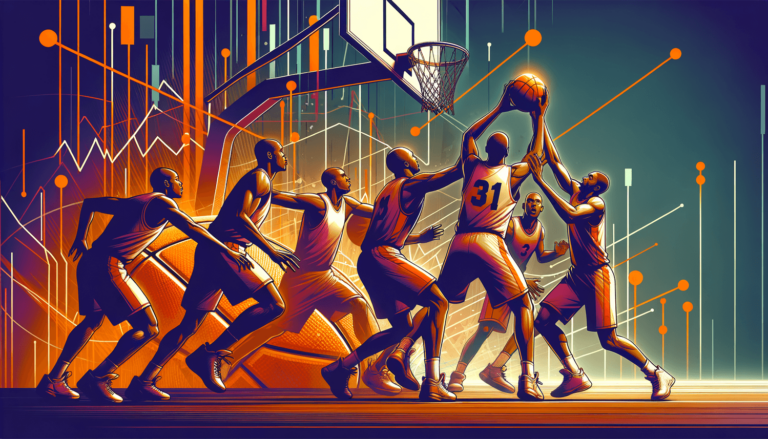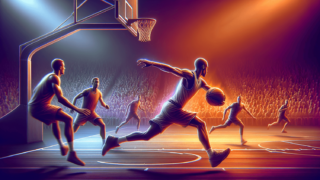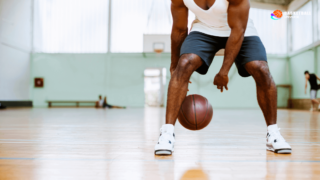
What’s a Strongside Help Defense in Basketball?
Written by: Basketball Universe
Last updated:

Welcome to the fascinating world of basketball defense strategies! In this blog post, we will delve deep into the realm of ‘Strongside Help Defense’ – a valuable team strategy that can elevate the effectiveness of individual defenders and the overall defensive prowess of the entire squad. So buckle up, basketball enthusiasts, as we take you on an exciting journey where your understanding of this crucial tactic will flourish, and your appreciation for the game will soar to new heights. Are you ready to unlock the secrets of one of the most powerful weapons in a team’s defensive arsenal? Let the adventure begin!
What’s a Strongside Help Defense in Basketball?
A Strongside Help Defense in basketball is a defensive strategy where an off-ball defender shifts towards the strong side (the side of the court where the ball is being played) to offer support and disrupt the offense’s scoring opportunities. This tactic relies on solid communication and quick response from teammates, allowing the team to cover any potential mismatches, close down driving lanes, and contest shots effectively.
The Fundamentals of Strongside Help Defense
Basketball requires a combination of individual skills and team tactics, particularly when playing defense. Strongside Help Defense is one such critical defensive strategy that helps teams cover the court more efficiently and counter the offense with increased effectiveness. With a blend of positioning, communication, and commitment, players perfecting this technique can dramatically impact the game. In this section, we will discuss the foundations needed to create a successful Strongside Help Defense.
Defender Positioning
Proper defensive positioning is crucial in executing an effective Strongside Help Defense. Generally, defenders must match up against their assigned offensive player while maintaining an awareness of the ball’s position. This “ball-you-man” concept implies that a defender should position themselves between the ball handler and their assigned player. As the ball shifts between players, defenders must adjust their positions accordingly.
Reading the Court
A keen understanding of the game’s various offensive and defensive schemes is essential for a successful Strongside Help Defense. Players must learn to evaluate the situation and make quick decisions based on real-time observations. Some key factors that help in reading the court include recognizing the offense’s preferred options or plays, identifying potential mismatches or isolation opportunities, and responding accordingly.
On-court Communication
Strong, clear communication between teammates is vital for proper defensive execution. Players should frequently communicate potential threats, make switches when necessary, and inform their teammates of any changes in offensive tactics. A well-coordinated team effectively executing Strongside Help Defense can successfully manage risk, limit scoring options, and generate turnovers.
Setting Up a Proper Strongside Help Defense
Executing the Strongside Help Defense requires an understanding of specific techniques and moves that assist defenders in anticipating and neutralizing offensive plays. In this section, we will break down some of the essential elements of a solid Strongside Help Defense.
One Pass Away Rule
The “One Pass Away” rule refers to a defender’s responsibility to help out if they are positioned one pass away from the ball handler. For instance, if the ball handler is facing a possible drive to the basket, the defender one pass away should slide over and provide help defense. This immediate support makes it difficult for the offense to exploit mismatches and makes it more challenging to score or create an open shot.
Hedge and Recover Technique
Another essential component, the “Hedge and Recover” technique, comes into play when the ball handler executes a pick-and-roll play. The player defending the screener, known as the “hedger,” will momentarily step out and impede the progress of the ball handler, giving their teammate ample time to recover and resume defensive responsibilities. The hedger then quickly returns to their assigned player, ensuring both offensive players are covered.
Stunting and Faking
Stunting and faking are techniques used by defenders to reduce the effectiveness of the offense’s passing game. Stunting may involve a quick jab step or a momentary dip to the passing lane, giving the impression of an imminent steal or double team. Faking, on the other hand, implies a slight defensive adjustment or fake movement that can disrupt the offensive player’s decision-making. Both techniques keep the offense guessing and allow the defense to maintain their positioning while contributing to the Strongside Help Defense.
Individual Defensive Skills for Strongside Help Defense Success
Alongside the tactical elements required for a successful Strongside Help Defense in basketball, individual defensive skills are critical in making this strategy even more potent. Here are some skills and considerations that players can develop and adopt to enhance their effectiveness within the Strongside Help Defense framework.
Footwork Fundamentals
Mastering footwork is essential to instantly respond to on-court movements and transitional plays. Strong footwork enables defenders to change direction quickly, maintain balance, and adjust their position according to the court situation. Quick, agile feet make a defender more effective in providing help defense, closing out on shooters, and keeping offensive players in check.
Active Hands
Keeping hands active throughout the defensive possession can make a significant difference in the outcome of the play. Active hands can lead to deflections, steals, and contested shots, disrupting the offensive flow. They also force the offense to be more cautious when making passes, adding pressure and increasing the likelihood of mistakes or turnovers.
Anticipation and Basketball IQ
Developing anticipation skills and basketball IQ allows defenders to recognize patterns and play developments in real-time, enabling them to move and position themselves appropriately. A defender with a high basketball IQ can read situations, predict opponent movements, and take advantage of opportunities to disrupt the offense and help their teammates defensively.
Adjusting Your Strongside Help Defense Based on the Opposition
A well-rounded Strongside Help Defense should adapt to the opposition’s offensive tactics and strengths. Teams with a strong inside scoring presence, such as dominant post players or aggressive driving guards, may require more focused help in the paint, while teams that primarily rely on perimeter shooting might need closeouts on three-point threats. In this section, we’ll discuss specific situations and how to adjust the Strongside Help Defense accordingly.
Defending against Slashers and Drivers
When facing a team with aggressive drivers and slashers, the Strongside Help Defense must prioritize protecting the paint and preventing easy layups. Defenders should collapse into the paint, rotate to provide help, and contest shots without fouling, forcing the opposing team to rely on jump shots or floaters in traffic.
Disrupting Three-Point Shooters
Against teams with multiple perimeter threats, defenders should be ready to close out aggressively on potential three-point shooters while other teammates rotate and provide help on the strong side. Communication is vital in these situations, as defenders will need to know who is rotating to provide help and which offensive player requires the most attention.
Controlling Dominant Post Players
Neutralizing a dominant post presence requires timely help from Strongside defenders. Consider sending a double team when the post player catches the ball in their preferred spot, forcing the offense to move the ball to another player or make a difficult pass out of the post. In other cases, help defenders can fake a double team, causing the post player to hesitate or make a hurried decision, allowing the on-ball defender to recover and contest the shot.
In summary, the Strongside Help Defense in basketball is a powerful tool that enhances the effectiveness of defenders and improves the overall defensive unity of a team. By understanding and mastering the fundamentals, learning various techniques, and recognizing specific adjustments that apply to different offensive strategies, players can elevate their game and contribute to a more comprehensive and effective defensive system.
Beyond the Strongside Help Defense: Complementary Defensive Concepts
While the Strongside Help Defense is an integral part of a team’s overall basketball defensive strategy, additional concepts contribute to a complete and dynamic defensive system. In this section, we will explore related ideas and how they work alongside the Strongside Help Defense to cover the full spectrum of defensive scenarios.
Weakside Help Defense
Connecting seamlessly with the Strongside Help Defense is its counterpart, the Weakside Help Defense. This concept focuses on players who are positioned on the weak side of the court, away from the ball. As the primary on-ball and strong-side defenders apply pressure, the weak-side defenders monitor the court, ready to rotate and provide assistance when necessary. Combined with the Strongside Help Defense, the Weakside Help Defense forms a comprehensive, coordinated defense strategy that addresses multiple threats across the court.
Rotation and Recovery
As defenders provide help on the strong side or collapse on the ball handler, it is crucial to have a detailed plan for recovering and filling in the gaps in the team’s defense. Rotation and Recovery rely on clear communication between teammates and swift movement, ensuring each player understands their responsibility and commits to covering any uncovered offensive players. The defense should constantly reevaluate their positioning and adapt to any changes in the offense to maximize the effectiveness of their Strongside Help Defense.
Transition Defense
An often-underappreciated aspect of a robust defensive strategy is the ability to transition from offense to defense quickly. A successful transition defense can prevent fast-break opportunities and force the offense to settle into a half-court set, making full use of the team’s Strongside Help Defense. Maintaining communication, sprinting back, and matching up with appropriate offensive players are essential skills for executing an effective transition defense.
Building a Defensive Philosophy That Fits Your Team
A basketball team’s defensive system should take into account the unique strengths and weaknesses of its roster. Coaching staff and players should be aware of their individual capabilities and preferences to create a customized defense strategy rooted in the Strongside Help Defense concept. Here are some factors to consider when crafting an approach that best suits your team.
Player Attributes
Each player brings their unique mix of height, speed, agility, and strength to the table. A successful defensive system should capitalize on these attributes to help maximize player potential. Coaches should be mindful of the physical capabilities of their players and adjust their Strongside Help Defense accordingly. For example, teams with excellent shot-blockers can focus on funneling opponents towards their rim protector, who can contest and alter shots.
Team Chemistry
Defensive chemistry is crucial for Strongside Help Defense success. Teams with strong connections on and off the court are better equipped to communicate effectively, anticipate, and react to teammates’ movements. Building trust and understanding between players via practice, film sessions, and team-building activities can go a long way in improving overall team defense.
Balancing Aggression and Caution
A team’s defensive philosophy should strike the right balance between aggressive and conservative strategies. In some cases, a team might prefer to emphasize an aggressive approach, such as pressing and trapping, to force turnovers and create fast-break opportunities. Other teams may opt for a more conservative philosophy, focusing on protecting the paint and closing out on shooters, forcing a lower percentage shot. Establishing a proper balance ensures the team’s Strongside Help Defense doesn’t become predictable and remains effective in different game situations.
In conclusion, the Strongside Help Defense is only one piece of the puzzle for building an impenetrable defense in basketball. A comprehensive, effective defensive system should encompass related concepts such as Weakside Help Defense, Rotation and Recovery, and Transition Defense. By understanding these ideas and tailoring a defensive philosophy that suits a team’s unique roster, coaching staff and players can create a dynamic and successful defensive strategy, making it a force to be reckoned with on the court.
Frequently Asked Questions About Strongside Help Defense
We understand that even with an in-depth discussion on the Strongside Help Defense, you may still have some questions or desire clarification on certain points. Below, we’ve prepared an FAQ section that tackles some of the most common queries regarding this critical defensive strategy.
1. Why is Strongside Help Defense important in basketball?
Strongside Help Defense is essential because it enhances the effectiveness of individual defenders and reinforces the overall defensive prowess of the team. By providing supporting coverage and disrupting the offense, the defense can limit scoring opportunities and protect the basket more effectively than relying on one-on-one defensive efforts.
2. How do you define the strong side of the court?
The strong side of the court refers to the side where the ball is being played, typically where the ball handler and the highest concentration of offensive players are positioned. The strong side can shift as the ball moves across the court, prompting continual adjustments in the defense’s positioning.
3. Can you still apply Strongside Help Defense against fast-paced offenses?
Absolutely! Strongside Help Defense can be adjusted and tailored to counter various offensive styles, including fast-paced offenses. It might necessitate quicker rotations, better communication, and a heightened focus on transition defense to ensure players are in proper defensive positions.
4. How do a team’s offensive players counter Strongside Help Defense?
Offensive players can counter Strongside Help Defense by utilizing off-the-ball movement, setting screens, and making quick, accurate passes to exploit defensive rotations. Spacing the floor effectively, driving and kicking the ball to open teammates, and maintaining offensive flow are crucial to dismantling Strongside Help Defense.
5. What is the biggest challenge in executing Strongside Help Defense?
One of the biggest challenges in executing Strongside Help Defense is maintaining seamless communication and rapid decision-making among defenders. Ensuring each player understands their defensive responsibilities, communicates constantly, and reacts swiftly to adjustments can make a significant difference in the effectiveness of the Strongside Help Defense.
6. What type of player is most suitable for providing help defense?
Players who possess quickness, anticipation, and strong basketball IQ tend to excel in providing help defense. Those who can read the floor, react to offensive actions, and initiate proper defensive rotations will find success in Strongside Help Defense.
7. How does Strongside Help Defense impact rebounding?
While executing Strongside Help Defense, positioning for rebounding can become more challenging due to players rotating and providing help. However, with proper communication and anticipation, teammates can step in and fill the gaps, maintaining a strong presence on the boards.
8. Can Strongside Help Defense lead to increased fouling?
If not executed correctly, Strongside Help Defense can lead to miscommunication, poor decisions, or late rotations, possibly resulting in fouls. However, a team that practices and perfects their Strongside Help Defense should see improved overall defense with more contested shots and fewer fouls.
9. How do teams practice Strongside Help Defense?
Teams practice Strongside Help Defense through drills designed to simulate various game situations, focusing on proper defensive positioning, rotation, and communication. Film sessions can help identify areas for improvement, allowing players to understand their responsibilities and the tactical elements of Strongside Help Defense better.
10. Can smaller teams effectively use Strongside Help Defense?
Yes, smaller teams can successfully utilize Strongside Help Defense by emphasizing speed, quick rotations, and tenacious on-the-ball defense. While a smaller team may lack height, proper execution of Strongside Help Defense can still create challenges for the opposing offense and limit their scoring opportunities.
11. How does a zone defense incorporate Strongside Help Defense principles?
A zone defense shares many similarities with Strongside Help Defense principles. It requires players to adjust their positions as the ball moves, provide help when needed, and maintain overall court awareness. The main difference between the two is that a zone defense focuses on guarding specific court areas rather than strictly matching up against individual offensive players.
12. Can applying Strongside Help Defense lead to mismatch problems?
It is possible for matchups to become mismatched during rotations in Strongside Help Defense situations. However, well-coached teams should be prepared to recognize and adjust to these mismatches quickly, relying on team defense and rotations to prevent any exploitation of the situation.
13. How does Strongside Help Defense contribute to creating turnovers?
Strongside Help Defense contributes to creating turnovers by suffocating offensive options, forcing difficult passing lanes, and closing out on shooters. Increased defensive pressure can lead to offensive mistakes, making them vulnerable to steals, deflections, and bad shot selections, ultimately resulting in turnovers.
Featured Posts
- No pillar pages found.





